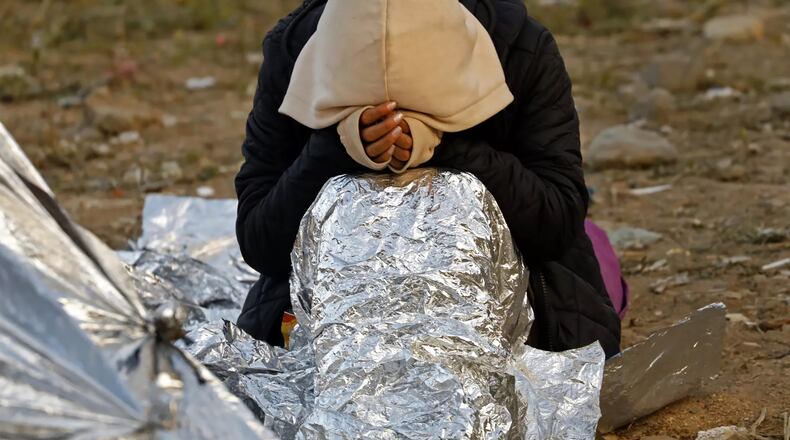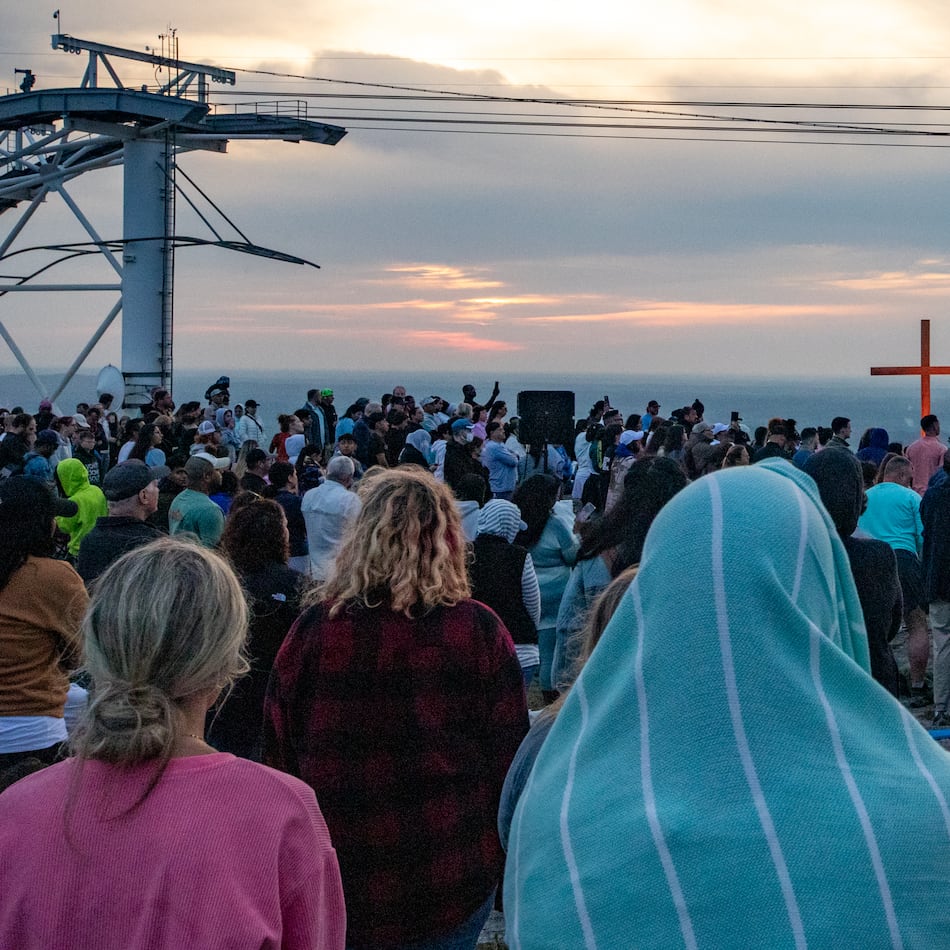On May 7, 2021, a Border Patrol agent arrested 16-year-old Emilia near Yuma, Arizona, for illegally crossing into the U.S. from Mexico. She had walked through a gap in the border wall, which in that area runs along the Colorado River and takes the form of heavy steel slats.
Emilia needed to leave her hometown in Honduras. Her mother was struggling to provide for her there, and she feared for her safety after gang members kidnapped a cousin. According to documents from the Justice Department, Emilia told authorities at the border that she was going to live with a family friend in Marietta.
In a Spanish-language interview with The Atlanta Journal-Constitution, Emilia said she had last seen the Marietta family friend, a man, when she was eight years old, but she was hopeful that joining his household would raise her standard of living.
“Nothing went as I had hoped,” she said.
Emilia alleged she was sexually abused by the family friend, whom federal authorities had released her to in June 2021.
She fled the home and her abuse was reported to Cobb County police, who confirmed her case is still under investigation. Now 18, Emilia is living in an area shelter for homeless youth.
Her story isn’t unique.
Juana made the difficult decision to come to the U.S. by herself to escape the poverty she and her family experienced in Guatemala.
“I was happy with my family. We didn’t have any money, but we smiled a lot,” she said. “But life isn’t always about love.”
Federal authorities released Juana to a male cousin, but she too was forced to flee abuse there. Juana is now in what may be an equally perilous situation, staying in a Marietta apartment with at least three unrelated adult men who have not been vetted by authorities.
Their similar stories reflect layers of failure in the immigration system. Increasing numbers of unaccompanied minors have been arriving to the U.S., with many falling off the federal government’s radar after they are processed and released to adult sponsors across the country.
When the host homes turn dangerous for the children, already overburdened foster-care systems are the first safety net.
Here in Georgia, the Department of Family and Children Services (DFCS) is responsible for helping, but undocumented youth are only eligible for services if they are under the age of 18, a rule that the agency recently tightened. Meanwhile, Georgia residents with legal status can remain in DFCS care for longer, until age 21.
After Emilia and Juana left their host homes, DFCS took them in and provided foster care for a time, but both were ousted from the system when they turned 18 earlier this year.
In the weeks leading up to the girls’ birthdays, a Cobb County Juvenile Court Judge had warned the agency that “kicking [them] out of care … would put [them] at immediate risk for sexual assault and victimization.” An attorney has filed lawsuits on the teens’ behalf to have DFCS take them back.
Without family or government support, both Emilia and Juana are now left to ponder an uncertain future, all while mourning a childhood cut short.
“I’ve been feeling very desperate — frustrated, stressed out,” Emilia told the AJC. “So much has happened in so little time. I came here when I was 16, I was still a kid. I don’t know. I feel like here was a part of my childhood I never got to live out.”
The AJC is not using the full name of either Emilia or Juana in keeping with its policy against naming the victims of sexual assault.
5,000 unaccompanied minors arrived in 2022
Over the past two years, as the pandemic and its aftermath eroded economic progress across Latin America, border agents have come across record levels of children traveling without family.
In fiscal year 2022, nearly 130,000 unaccompanied minors were released from federal shelters into the homes of adult sponsors, up from roughly 30,000 in 2015, according to government data posted online by U.S. Department of Health and Human Services. Of last year’s nearly 130,000 releases, 5,200 wound up in Georgia. In 2015, by comparison, the state received just over 1,000 migrant children.
“We are just drowning,” said Andrea Landers, an immigration attorney with Atlanta Legal Aid who helps provide free legal representation to migrant children in the area.
It’s a vulnerable population: Unaccompanied migrant children lack legal status and have deportation orders to challenge. They often feel intense pressure to earn money, with relatives back home expecting support and as is often the case, smuggling debt to pay off. That puts them at greater risk of trafficking and exploitation, experts say.
HHS is responsible for keeping migrant children safe and ensuring their hosts in the U.S. will protect them, but there are signs the department is falling short.
A February report by The New York Times showed that the agency, which checks on all minors by calling them a month after they’ve moved in with their sponsors, lost immediate contact with more than 85,000 children over the last two years — roughly a third of all arrivals.
In an audit report published in June, HHS maintained that it is able to reach either the child, the sponsor or both in more than 80% of cases. A spokesman told the AJC in a statement that HHS “works diligently to make sure every placement decision is made in the best interest of the child.” The spokesman added that, although HHS collaborates with law enforcement and other partners when it learns that children’s safety is at risk, its “custodial responsibilities end when a child is released from” care.
Credit: JOHN BURCHAM
Credit: JOHN BURCHAM
Unencumbered by formal follow-up from federal or local agencies, some sponsors who take in migrant children are putting them to work illegally in hazardous jobs. According to the U.S. Department of Labor, the increase of children arrivals has coincided with a spike in violations of child labor laws.
Emilia’s story and allegation of sexual assault point to another alarming situation that can arise after children are placed in the care of adults they barely know, with no checks to guarantee they are treated well. When girls are released into the custody of unrelated, adult men, in Landers’ view it “always raises a red flag.”
Emilia’s living situation became untenable during the 2021 Christmas break, just over six months after she arrived in Marietta. According to court filings from DFCS, Emilia’s sponsor allegedly assaulted her twice. At least one of the attacks reportedly took place while Emilia was unconscious after the sponsor had served her an alcoholic drink.
Emilia fled to the home of a friend from school, and police opened an investigation. Weeks later, she entered DFCS custody and became a charge of the state.
Limited follow-up
As stipulated in Bush-era human trafficking legislation, non-Mexican minors are allowed to live in the U.S. while their cases play out in immigration court. After they’ve crossed the border, they are transferred into the custody of HHS, which works to facilitate placements into the homes of adult sponsors who have been vetted by the agency.
“There is this pressure because [HHS] wants to make sure they’re doing right by kids and getting them out of these federal custody situations as quickly as possible. But it’s a delicate balance between getting them out and making sure … that you’re sending the kids to a safe home,” said Jennifer Podkul, vice president for policy and advocacy at Kids in Need of Defense (KIND), an organization that provides legal services to unaccompanied minors.
The first choice of Emilia’s family was for her to join an uncle who lives in the U.S., but he declined to be her caretaker. As an undocumented immigrant, he was wary of getting on immigration authorities’ radar.
For Podkul, the biggest issue in HHS’ handling of migrant children is that follow-up case management is far from universal, unlike in the foster care system. Last year, roughly 40% of unaccompanied minors received “post-release services,” up from 20% in 2021, according to HHS’ own data. At a basic level, post-release services only help connect families and sponsors to community resources.
“As they expedite the reunifications on the front end, they got to up the back-end protections, and make sure there are people looking in on the kids,” Podkul said. That would “make a world of difference for their safety.”
In its June audit report, HHS says it is working to expand post-release services.
In Georgia, one of the nonprofits that works with HHS to provide case management for migrant children is Catholic Charities Atlanta. According to Vanessa Russell, the organization’s CEO, finding enough caseworkers to keep up with the increase in migrant children arrivals isn’t an easy task.
“I think in general we could say that it’s unsafe for children to be making this kind of journey,” she said. “The journey is unsafe. Then, what can happen to them when they get here is a huge question mark.”
‘I wanted to help my parents’
Like Emilia, Juana was also 16 when she set off to the U.S. from her home in Central America.
She lived in Nebaj, a town in the western Guatemalan highlands, where residents speak the Mayan Ixil language. It was a hardscrabble life: Juana shared a two-bedroom adobe house with her parents and six siblings. Her dad, a farmworker, had gotten injured and couldn’t work. Her mom washed clothes. Money was tight and groceries not always something they could afford.
The family went into debt to pay a smuggler 48,000 quetzals, around $6,000, to bring Juana to the border.
The journey north was brutal. It included travel through Mexico in the back of a tractor-trailer crowded with other migrants.
“It was hot, there was no air. We were all standing,” Juana said. “I passed out several times, but I never gave up.”
Juana crossed into the U.S. in October 2021. She says HHS released her into the care of a male cousin in Florida, whose name her family had provided. Instead of enrolling her in school, he found her a job at a plant nursery, working full-time.
“It was very tiring, but I wanted to get ahead so I didn’t care,” she said.
Roughly six months later, Juana came with a friend to metro Atlanta, where she moved into a house with at least three adult men. She wouldn’t tell an AJC reporter what caused her to leave Florida, but a lawyer working on her behalf says the likeliest reason is she was sexually abused by her cousin.
Georgia child welfare authorities learned of Juana in August 2022, when she arrived by ambulance at Wellstar Kennestone Hospital in Cobb County, and it was determined that she had no parent or legal caretaker in the area. According to DFCS, Juana arrived at the hospital “for treatment of a sexually transmitted disease and/or other illness.” By the end of the month, the agency had placed her in a group home for children and teens in Columbus.
A smaller safety net
In Georgia, most youth in the foster care system aren’t ready to leave it when they reach legal age. On average, around three quarters of those newly turned 18 sign up for “extended” services, which are available up until their 21st birthday. Under state law, 18 is also the age immigrants become barred from receiving public benefits if they are living in the country without authorization.
As recently as two years ago, DFCS could make accommodations for migrant youth who were on track to get a green card, or permanent residency, even if they hadn’t reached the end of that lengthy application process, according to Landers.
But a DFCS directive from October 2021 — weeks after a leadership change at the agency that oversees DFCS — eliminated that flexibility. Now, if children don’t beat the odds and secure a green card before their 18th birthday, they are transitioned out of the foster care system.
Emilia and Juana’s stories suggest DFCS is also falling short when it comes to helping vulnerable migrant youth in their custody move on to a stable living arrangement after leaving foster care.
In Emilia’s case, her youth shelter has voluntarily agreed to let her stay on despite the discontinuation of public funding — a stroke of luck, according to the girls’ lawyer and child welfare advocate Rebeca Salmon.
Juana was less fortunate. Two days after her 18th birthday, she was back in the Marietta apartment welfare authorities had taken her from just months prior, where at least three unrelated, unvetted adult men live. Cobb County Juvenile Court Judge Amber Patterson called that turn of events “absolutely outrageous,” according to court documents, adding, “the child was abandoned without a cent in her pocket.”
Judge Patterson has repeatedly ordered DFCS to continue providing services to Emilia and Juana, citing the agency’s failure to help start immigration processes while the girls were in its care. DFCS lawyers have fought the court’s ruling, saying because the girls are 18, the Cobb Juvenile Court no longer has jurisdiction and DFCS no longer has custody, an approach Salmon describes as running out the clock.
In a statement, DFCS spokesperson Kylie Winton said, “For all young people who exit DFCS care at age 18, DFCS makes efforts not only to educate the youth about his or her options, but also to connect the youth with available community resources and individuals in the community to whom the young person can go to for support.”
As Salmon continues to fight to get her clients enrolled in extended foster care, the attorney is especially worried about Juana, whom she says will likely drop out of school.
“She’s scared. What if [the men who have taken her in] stop feeding her? Maybe she’s scared of what she’s going to have to do to eat,” she said.
Juana acknowledges that the upside of school isn’t clear to her, though she would like to learn English.
“Miss Rebeca [Salmon] says that I need to study, but it’s becoming really difficult, because I don’t have any money.”
She says she can’t stop thinking about the debt her family owes to the smuggler who helped her reach the U.S.
“That’s something that worries me a lot. It makes me depressed. I wonder a lot about how I’m going to get that money, how I’m going to pay for my food and my rent. I don’t know. I am full of worries.”
Despite the challenges, she remains convinced there’s a better future to be had here than back home.
“I don’t regret coming.”
How we got this story:
In March, attorney and child welfare advocate Rebeca Salmon reached out to The Atlanta Journal-Constitution to let the newspaper know about Emilia and Juana’s stories. A reporter met and spoke with the teens in a waiting area inside the Cobb County Juvenile Court, on a day both were due for a hearing in their suits against DFCS. More details about the teens’ situation in the U.S. and back in Central America were gathered during ensuing phone interviews with Emilia and Juana, and by reviewing court records as well as documents from state and federal agencies.
The Atlanta Journal-Constitution and Report for America are partnering to add more journalists to cover topics important to our community. Please help us fund this important work at ajc.com/give
About the Author
Keep Reading
The Latest
Featured




